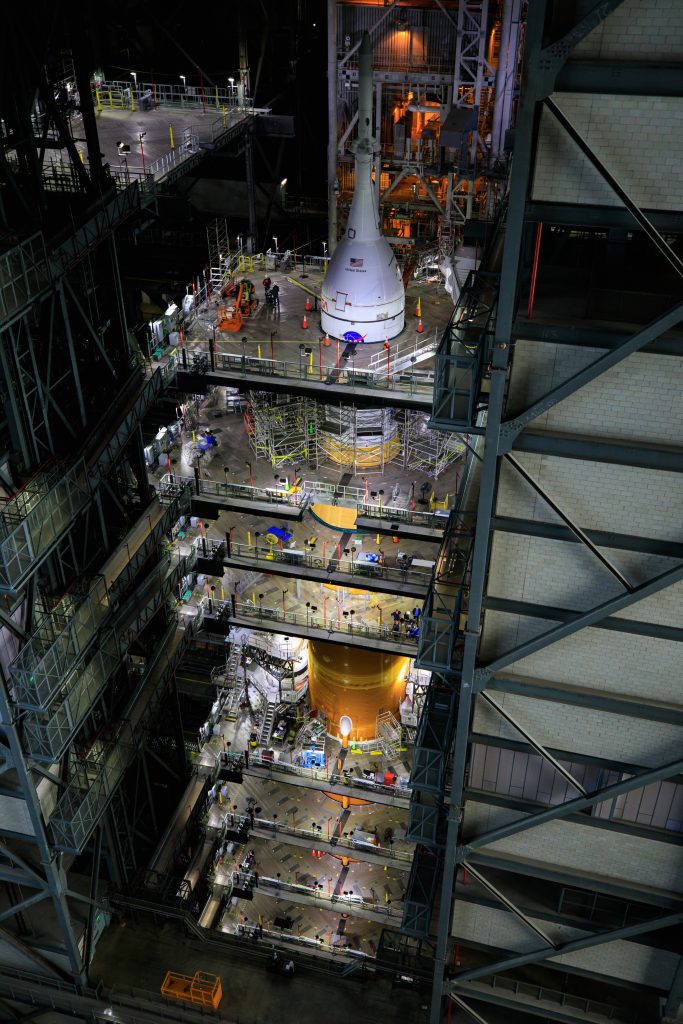
SLS heading back to the VAB
Following a successful launch dress rehearsal earlier this week of its newest moonship, NASA plans to launch the Artemis 1 mission within a handful of weeks. The agency will send the Orion spacecraft to the moon atop the Space Launch System (SLS) – a first step in humanity’s return to the lunar surface by 2025 – as soon as the end of August. There will be no astronauts onboard for this trip around the moon and back.
At a post-rehearsal briefing on Friday (June 24, 2022), Catherine Hamilton from NASA’s Office of Communications summed up what’s next for Artemis 1:
NASA has reviewed the data from the rehearsal and determined that the testing campaign is complete. The rehearsal is the final major task needed before launch, and now the agency will roll the SLS and Orion back to the Vehicle Assembly Building (VAB) next week to prepare the rocket and spacecraft for their flight test.
Rollback from Launch Pad 39B at Kennedy Space Center in Florida should start on Friday (July 1, 2022), weather permitting.
Listen to the entire Artemis 1 media update here:
SLS and launch crew ready
The launch rehearsal was an overall success, yet the launch team didn’t get as close to T-0 as they’d planned, ending the test with about 29 seconds remaining on the countdown clock.
Tom Whitmire, deputy associate administrator for NASA’s Common Exploration Systems, said almost all of the unfinished tasks and the associated systems have already been put through their paces during previous testing.
The launch rehearsal is the final step in a long process of learning how to prepare and fly the SLS. At the NASA briefing, Whitmire described it like this:
It’s something that we’re building knowledge up incrementally over time. So when you look at each of these activities, you have to also kind of compare them to other activities that we’ve done.
Like a stage crew readying for opening night, every member of the SLS launch crew must know their job and when to do it. Rehearsing finds any kinks in the process. Whitmire again:
We knew that we would never actually turn on the engines or start up the rocket, and therefore it was in design really to rehearse the loading operations and the detanking operations, and really take a look across all our sites to make sure people had the right information and (were) working together.

NASA’s SLS troubleshooter on Cloud Nine
During the post-test briefing, Whitmire described Phil Weber, the senior technical integration manager for the Exploration Ground Systems Program at NASA’s Kennedy Space Center, as the SLS team’s troubleshooter. Weber said he was thrilled with the outcome of the rehearsal:
I was actually floating on Cloud Nine when I drove home Monday after the test. It was a long day for a lot of us, but we stuck with it and got all the way through it.
Weber said only 13 commands weren’t tested during the missing 29-plus seconds of countdown time, and most of those have already been validated. There are two problems that have to be addressed before the rocket flies: a leak in a hydrogen line and a flow problem in a liquid oxygen line. The senior tech was hopeful the LOX repair would not take long:
We’ve already got a good head start on getting that fixed, so I think one’s going to be relatively easy.
Getting the hydrogen leak under control may prove trickier. Hydrogen, the smallest molecule in the universe, is notoriously difficult to contain.
6 to 8 weeks of launch prep
Of prime importance to the launch crew is knowing they can put the rocket back into its safe configuration should a real launch be scrubbed while the SLS is loaded with highly reactive fuel. Weber said knowing how to put the beast-like SLS back to sleep is critical:
When you get this thing fueled, and you’ve got the ordinance connected, and the safe, and arms into the arm position, you really got a tiger by the tail. So if something does go off nominal you’ve got to make sure that you can actually safe the vehicle and keep it under control.
Only three of the 72 commands planned during the rehearsal to put the SLS into safe mode were missed.
All that remains before returning the SLS to the VAB is a testing of the leaking hydrogen line while the rocketship is still in launch configuration and a test of the vehicle’s booster hydraulic power units.
The ground crew will then spend six to eight weeks working on the SLS to ready it for the Artemis 1 launch, which could come as soon as the second half of August.
Bottom line: The SLS launch rehearsal was successful, and the Artemis 1 moon mission could launch by the end of August.











